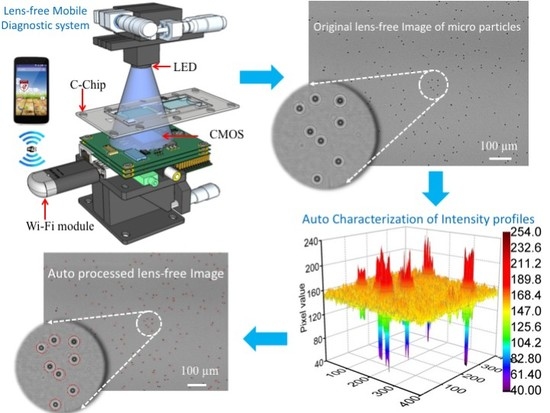Automated Micro-Object Detection for Mobile Diagnostics Using Lens-Free Imaging Technology
Abstract
:1. Introduction
2. Material and Methods
2.1. Lens-Free Imaging
2.2. Sample Preparation
2.2.1. Polystyrene Microbeads
2.2.2. RBCs
2.2.3. HepG2 Cells
2.2.4. MCF7 Cells
2.2.5. HeLa Cells
2.3. Algorithm
2.3.1. Summary of the Algorithm
2.3.2. Study of Diffraction Images
2.3.3. Signal Acquisition
2.3.4. Clustering
2.3.5. Diffraction Parameter Acquisition
2.3.6. Circularity Filter
2.3.7. Size Determination
3. Results and Discussion
4. Conclusions
Supplementary Materials
Acknowledgments
Author Contributions
Conflicts of Interest
References
- Li, P.; Lin, B.; Gerstenmaier, J.; Cunningham, B. A new method for label-free imaging of biomolecular interactions. Sens. Actuator B Chem. 2004, 99, 6–13. [Google Scholar] [CrossRef]
- Purvi, N.; Giorgio, T. Cell size and surface area determined by flow cytometry. Ann. N. Y. Acad. Sci. 1994, 714, 306–308. [Google Scholar] [CrossRef]
- Kumar, A.; Patton, M.; Hennek, J.; Lee, S.; D’Alesio-Spina, G.; Yang, X.; Kanter, J.; Shevkoplyas, S.; Brugnara, C.; et al. Density-based separation in multiphase systems provides a simple method to identify sickle cell disease. Proc. Natl. Acad. Sci. USA 2014, 111, 14864–14869. [Google Scholar] [CrossRef] [PubMed]
- Richards, A.; Dickey, M.; Kennedy, A.; Buckner, G. Design and demonstration of a novel micro-Coulter counter utilizing liquid metal electrodes. J. Micromech. Microeng. 2012, 22, 115012. [Google Scholar] [CrossRef]
- Stewart, J.; Pyayt, A. Photonic crystal based microscale flow cytometry. Opt. Express 2014, 22, 12853–12860. [Google Scholar] [CrossRef] [PubMed]
- Greenbaum, A.; Luo, W.; Su, T.-W.; Göröcs, Z.; Xue, L.; Isikman, S.; Coskun, A.; Mudanyali, O.; Ozcan, A. Imaging without lenses: Achievements and remaining challenges of wide-field on-chip microscopy. Nat. Methods 2012, 9, 889–895. [Google Scholar] [CrossRef] [PubMed]
- Bishara, W.; Su, T.-W.; Coskun, A.; Ozcan, A. Lensfree on-chip microscopy over a wide field-of-view using pixel super-resolution. Opt. Express 2010, 18, 11181–11191. [Google Scholar] [CrossRef] [PubMed]
- Isikman, S.; Bishara, W.; Mavandadi, S.; Yu, F.; Feng, S.; Lau, R.; Ozcan, A. Lens-free optical tomographic microscope with a large imaging volume on a chip. Proc. Natl. Acad. Sci. USA 2011, 108, 7296–7301. [Google Scholar] [CrossRef] [PubMed]
- Seo, S.; Su, T.-W.; Tseng, D.; Erlinger, A.; Ozcan, A. Lensfree holographic imaging for on-chip cytometry and diagnostics. Lab Chip 2009, 9, 777–787. [Google Scholar] [CrossRef] [PubMed]
- Zhu, H.; Isikman, S.; Mudanyali, O.; Greenbaum, A.; Ozcan, A. Optical imaging techniques for point-of-care diagnostics. Lab Chip 2013, 13, 51–67. [Google Scholar] [CrossRef] [PubMed]
- Ozcan, A.; Demirci, U. Ultra wide-field lens-free monitoring of cells on-chip. Lab Chip 2008, 8, 98–106. [Google Scholar] [CrossRef] [PubMed]
- Kim, S.; Bae, H.; Koo, K.; Dokmeci, M.; Ozcan, A.; Khademhosseini, A. Lens-free imaging for biological applications. J. Lab. Autom. 2012, 17, 43–49. [Google Scholar] [CrossRef] [PubMed]
- Roy, M.; Jin, G.; Seo, D.; Nam, M.-H.; Seo, S. A simple and low-cost device performing blood cell counting based on lens-free shadow imaging technique. Sens. Actuators B Chem. 2014, 201, 321–328. [Google Scholar] [CrossRef]
- Roy, M.; Seo, D.; Oh, C.-H.; Nam, M.-H.; Kim, Y.; Seo, S. Low-cost telemedicine device performing cell and particle size measurement based on lens-free shadow imaging technology. Biosens. Bioelectron. 2015, 67, 715–723. [Google Scholar] [CrossRef] [PubMed]
- Jin, G.; Yoo, I.-H.; Pack, S.; Yang, J.-W.; Ha, U.-H.; Paek, S.-H.; Seo, S. Lens-free shadow image based high-throughput continuous cell monitoring technique. Biosens. Bioelectron. 2012, 38, 126–131. [Google Scholar] [CrossRef] [PubMed]
- Alyassin, M.; Moon, S.; Keles, H.; Manzur, F.; Lin, R.; Hæggstrom, E.; Kuritzkes, D.; Demirci, U. Rapid automated cell quantification on HIV microfluidic devices. Lab Chip 2009, 9, 3364–3369. [Google Scholar] [CrossRef] [PubMed]
- Mondini, S.; Ferretti, A.; Puglisi, A.; Ponti, A. Pebbles and PebbleJuggler : Software for accurate, unbiased, and fast measurement and analysis of nanoparticle morphology from transmission electron microscopy (TEM) micrographs. Nanoscale 2012, 4, 5356–5372. [Google Scholar] [CrossRef] [PubMed]
- Gontard, L.; Ozkaya, D.; Dunin-Borkowski, R. A simple algorithm for measuring particle size distributions on an uneven background from TEM images. Ultramicroscopy 2011, 111, 101–106. [Google Scholar] [CrossRef] [PubMed]
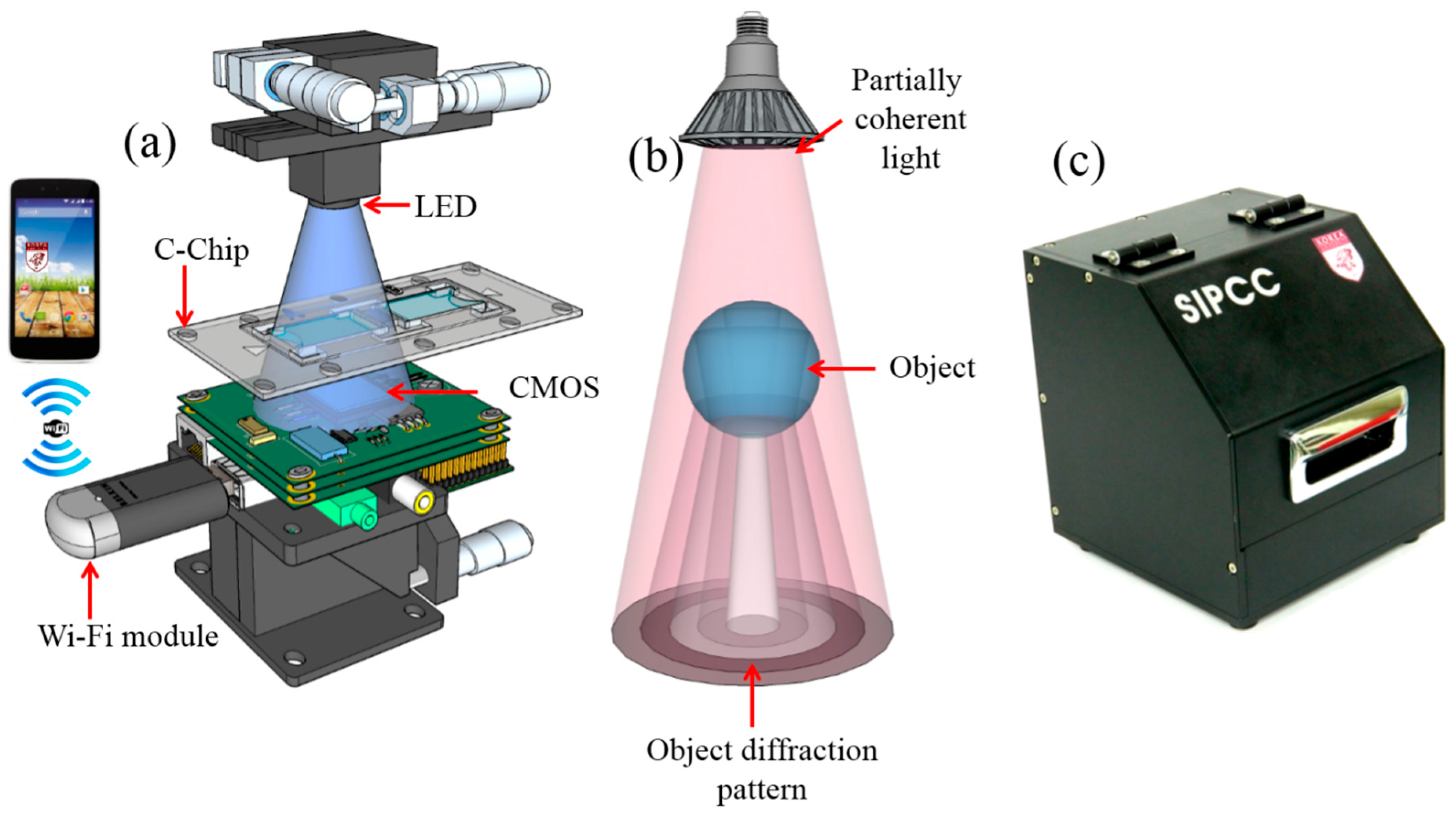


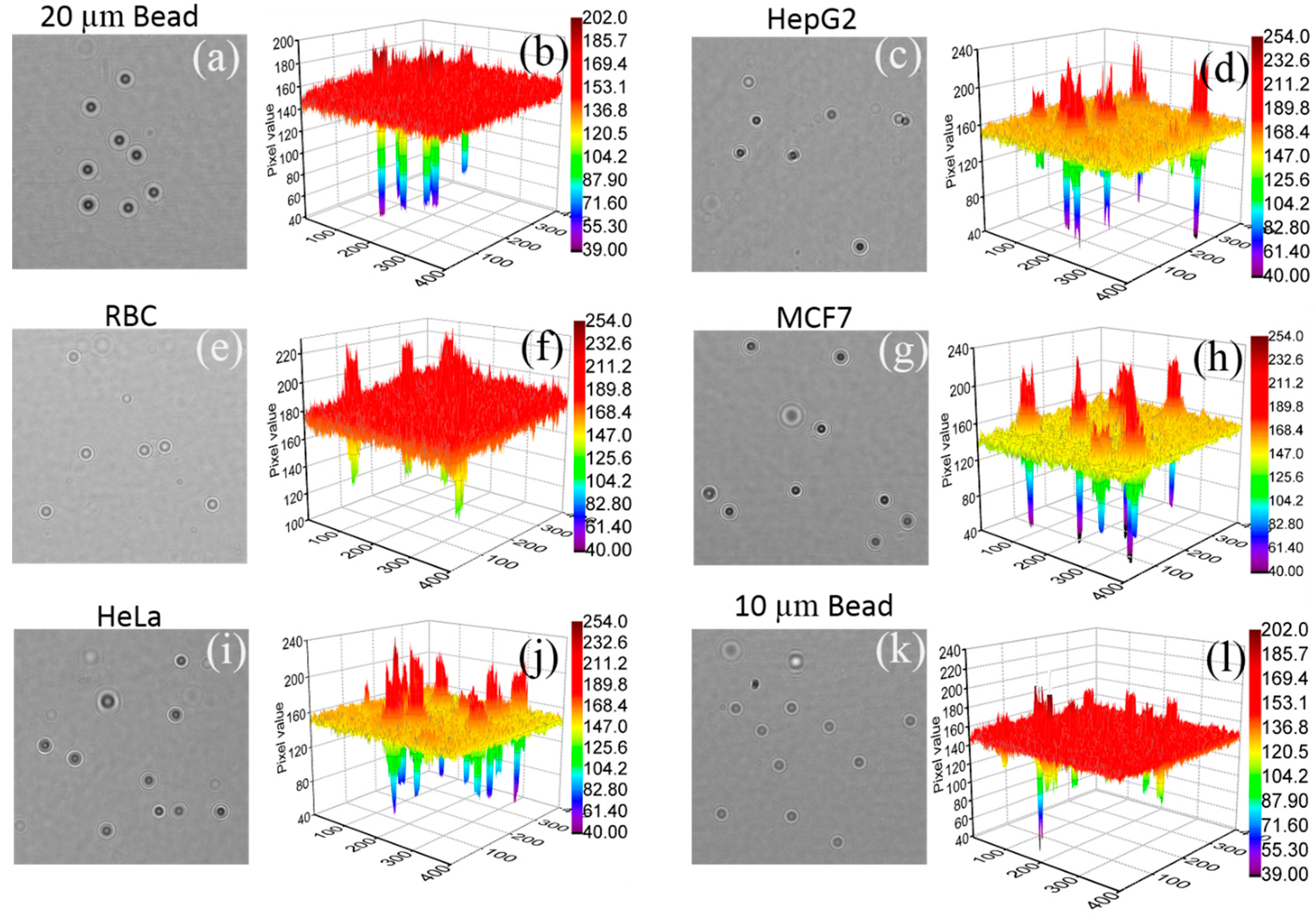
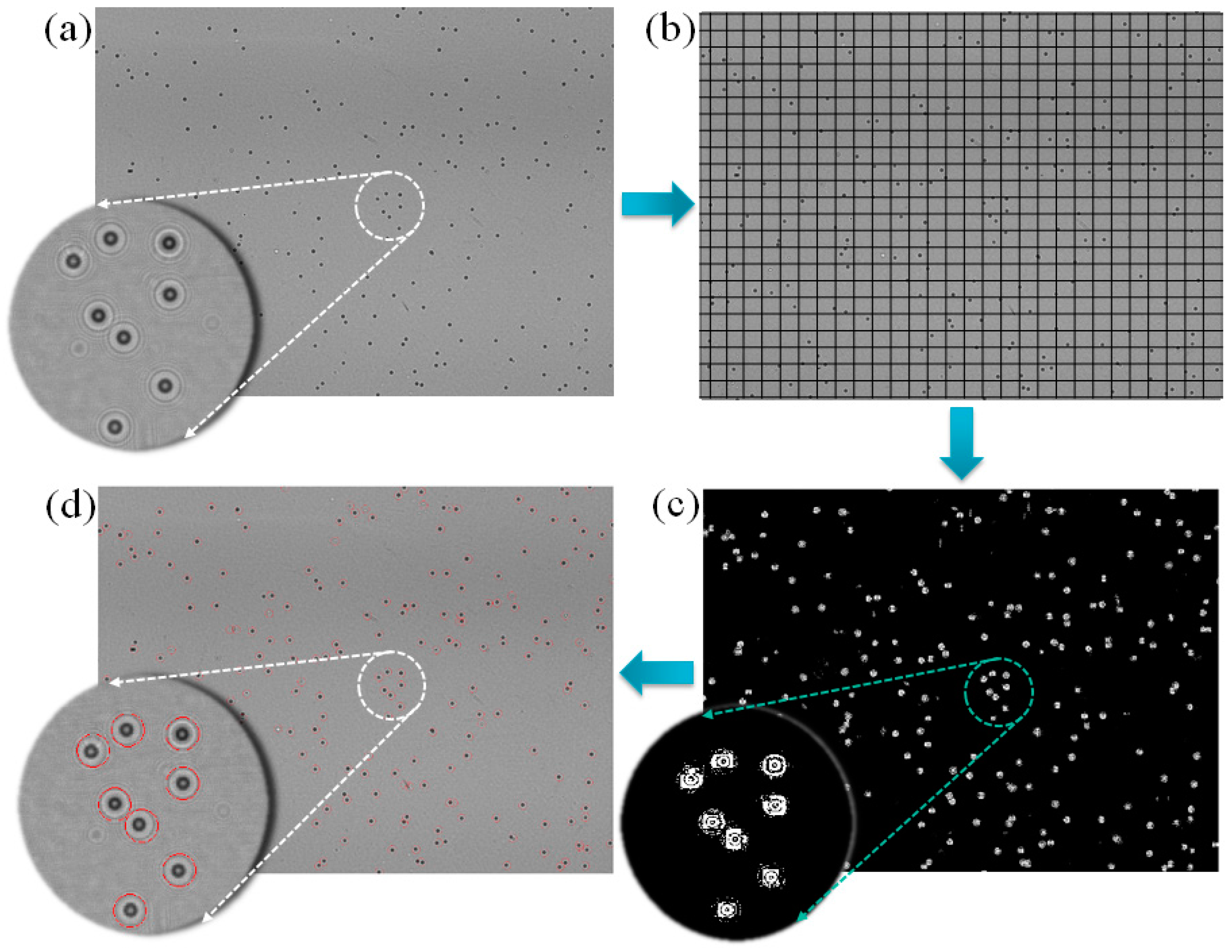
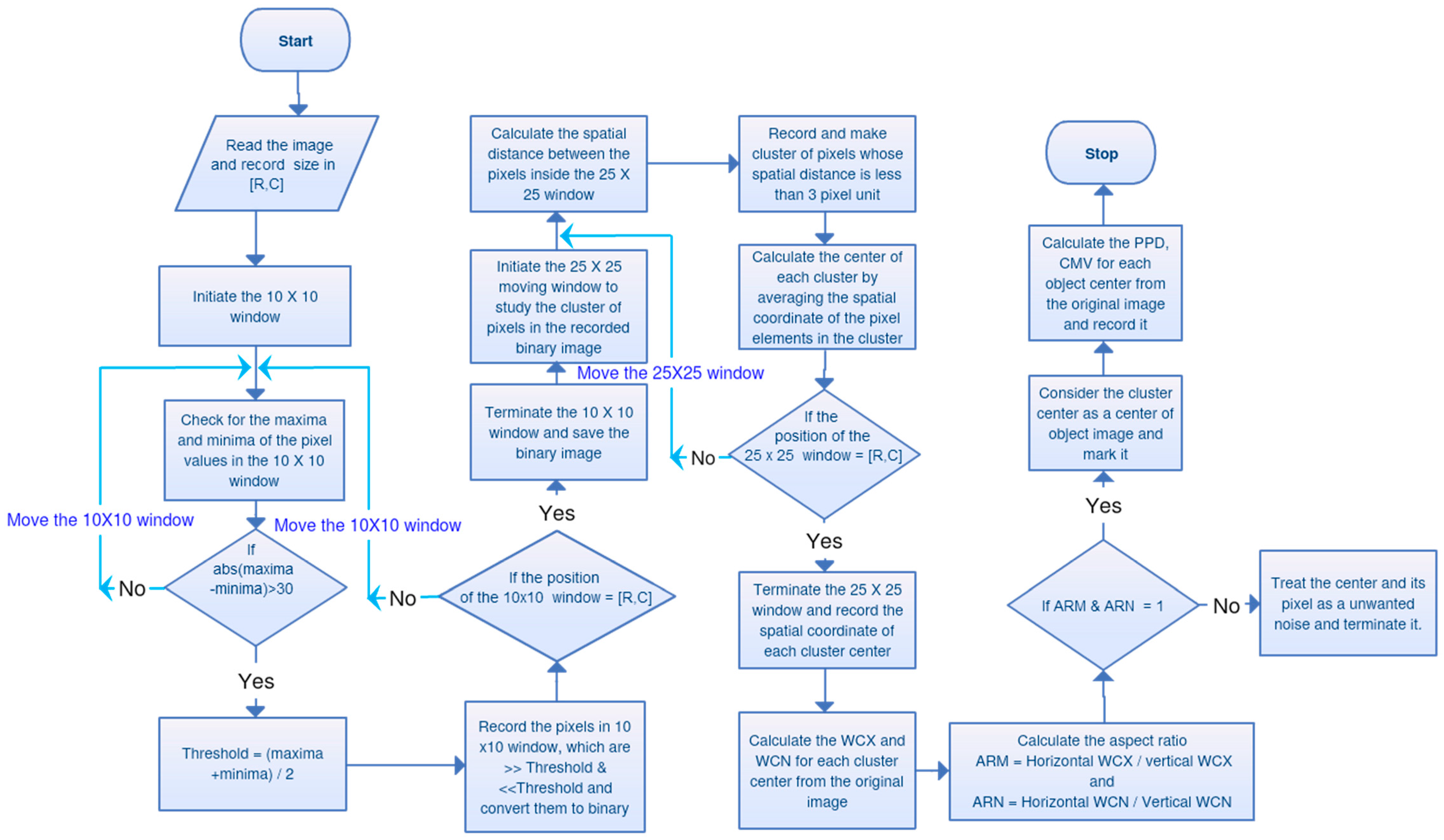
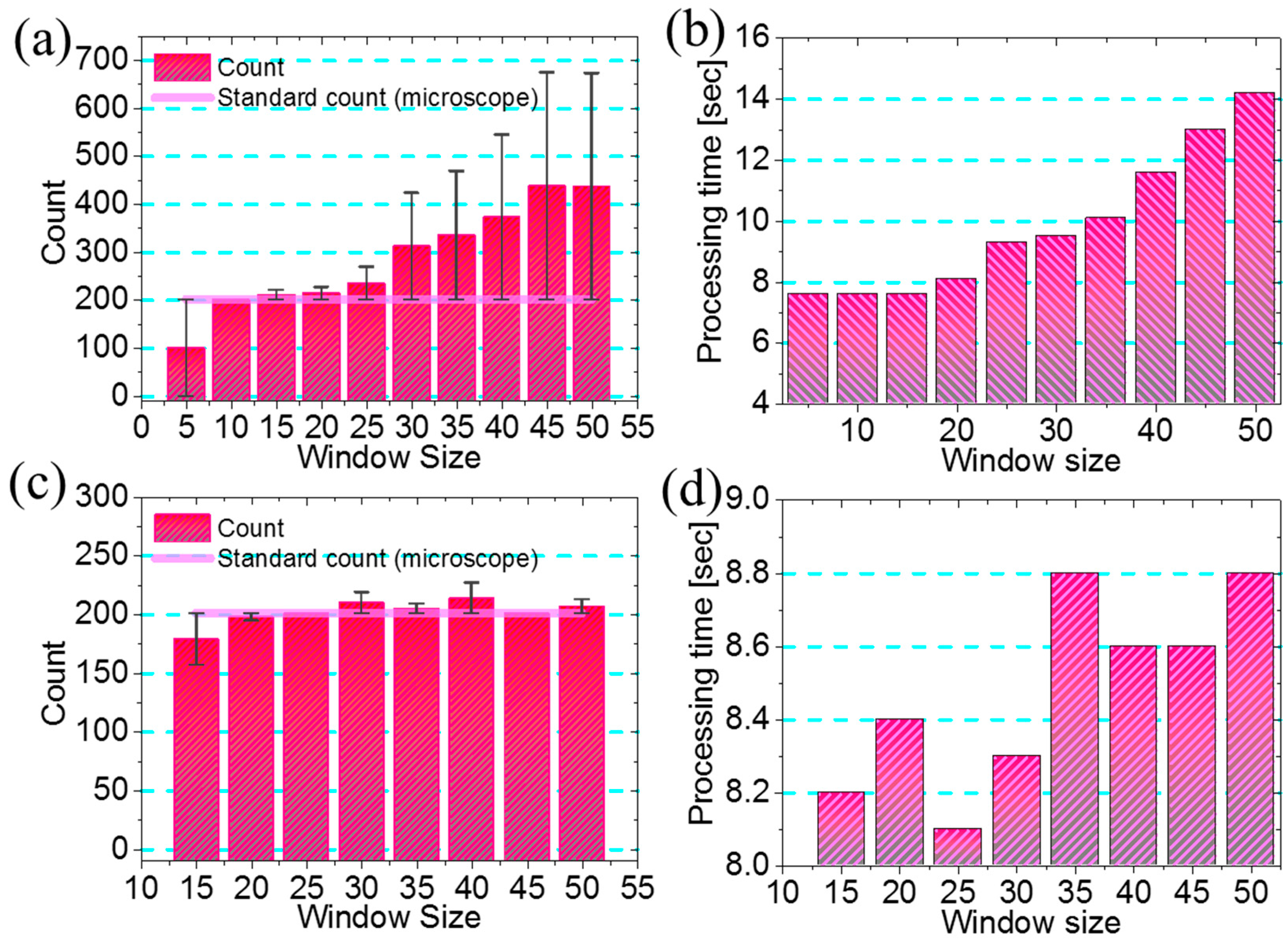
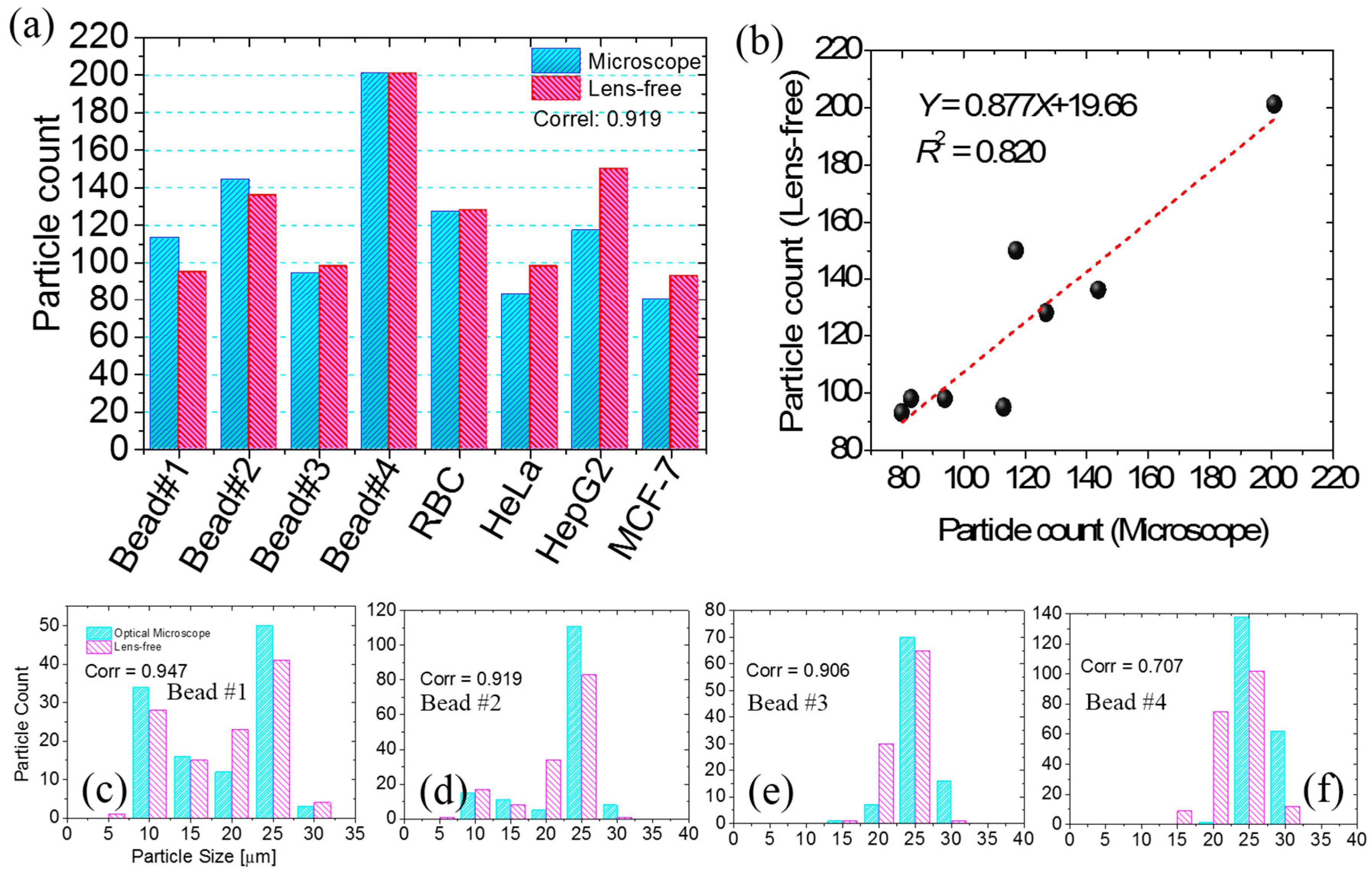
| Sample/Diffractin Parameters | 10 μm Bead | 20 μm Bead | RBC | HeLa | HepG2 | MCF7 |
|---|---|---|---|---|---|---|
| CMV | 144 | 132 | 176 | 149 | 151 | 139 |
| WCX | 8 | 7 | 11 | 6 | 7 | 7 |
| WCN | 4 | 4 | 5 | 4 | 5 | 4 |
| PPD | 38 | 86 | 69 | 65 | 89 | 85 |
© 2016 by the authors; licensee MDPI, Basel, Switzerland. This article is an open access article distributed under the terms and conditions of the Creative Commons Attribution (CC-BY) license (http://creativecommons.org/licenses/by/4.0/).
Share and Cite
Roy, M.; Seo, D.; Oh, S.; Chae, Y.; Nam, M.-H.; Seo, S. Automated Micro-Object Detection for Mobile Diagnostics Using Lens-Free Imaging Technology. Diagnostics 2016, 6, 17. https://doi.org/10.3390/diagnostics6020017
Roy M, Seo D, Oh S, Chae Y, Nam M-H, Seo S. Automated Micro-Object Detection for Mobile Diagnostics Using Lens-Free Imaging Technology. Diagnostics. 2016; 6(2):17. https://doi.org/10.3390/diagnostics6020017
Chicago/Turabian StyleRoy, Mohendra, Dongmin Seo, Sangwoo Oh, Yeonghun Chae, Myung-Hyun Nam, and Sungkyu Seo. 2016. "Automated Micro-Object Detection for Mobile Diagnostics Using Lens-Free Imaging Technology" Diagnostics 6, no. 2: 17. https://doi.org/10.3390/diagnostics6020017






